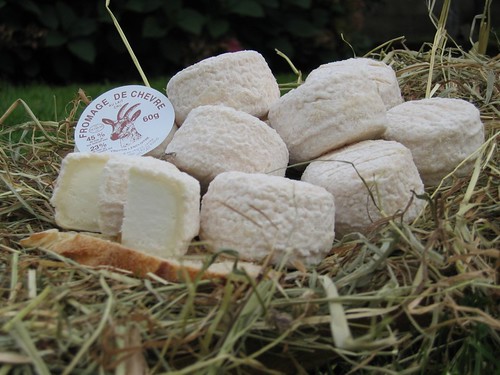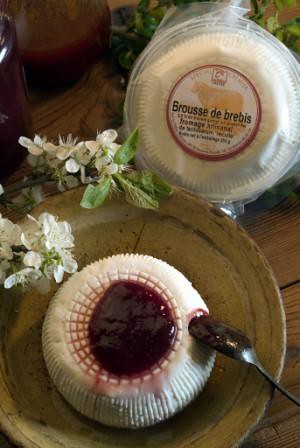Say Chèvre!
Chèvre, which means both goat and goat cheese, has long been part of the Provençal menu.
The story goes (it may also be true), that around 600 BC, a Phoenician ship carrying goats was wrecked near Marseille. The goats wandered a few kilometres east to the village of Le Rove, where they ate wild rosemary, thorny broom, prickly oak, and other tasty shrubs. Soon, they were providing the villagers with meat, and milk to drink and make a cheese called brousse.
You can now find brousse in almost every Provençal market. Serve brousse with a sprinkle of olive oil or a pinch of fleur de sel, or eat it as a dessert with a touch of honey and crushed nuts.
Most goat cheese is made by allowing raw milk to curdle and drain, and then the curds are pressed into shapes: cones, wheels, pyramids, buttons, logs, and discs or pucks called crottin. In a warm home kitchen, the milk may be hung in a cheesecloth to drain over the sink for several days. Or, as with brousse, the milk may be ladled into slotted moulds to drain.
The fresh goat cheese may be sold plain or flavoured with crushed black pepper corns, herbes de Provence or other spices. Chèvre may also be aged – brined to form a rind and stored in a cool place, but for no more than four months. The texture of chèvre ranges from creamy to crumbly to semi-firm and the taste is just as varied, although they all have a refreshingly tangy tartness.
The diet of the goats influences the taste of the cheese. In spring, when the goats roam freely to graze on wild herbs, the milk is sweeter and the cheese tastes of grass. Fall milk, however, tends to produce a slightly more bitter cheese. With goats, unlike cows, the milk production is seasonal – mid-March through October, with the greatest flow in the warm months.
Visiting a goat farm is a delight. When I arrange tours, guests are always impressed with the cleanliness of the facilities and how playful and charming the goats are. Also, there is always a wonderful cheese to taste.
As for wine and olive oil, the French Government classifies, protects and regulates nearly 60 cheeses and gives them an AOC (Appellation d’Origine Contrôlée) accreditation. The AOC cheeses include the popular banon, which is creamy and both sweet and strong, made from non-pasteurized goat milk.
A banon is delicately wrapped in brown chestnut leaves, tied with raffia and aged for a minimum of 15 days. Each one is like a little present for the palate. For AOC accreditation, only three local breeds of goat milk can be used and these goats must graze in a pasture for at least 210 days a year. The village of Banon, in the heart of the Lubéron, honours its cheese with a yearly festival La Fête du Fromage, this year scheduled for May 20th.
Picodon, another AOC cheese, is small (about 100g), smooth, and rather dry. The cheese, with its slightly piquant or spicy sharpness, has been on Provençal tables since the 14th century. The cheese blends naturally with the flavourful greens like arugula, but can also be eaten as a snack, tucked into a sandwich or grilled (when chèvre is served hot, it is known as chèvre chaud).
Goat cheese is lower in fat, calories and cholesterol than cow’s milk cheese. And people, even those who are lactose intolerant, find that goat cheeses are more easily digested than other dairy products. Still, the most important reason for eating the goat cheeses of Provence is for the taste. There are so many wonderful cheeses. Have I mentioned Rouleau de Provence? Saint-Marcellin? Pair any and all, with any rosé made from a syrah or grenache. Ah!
Image credits:1. recettes-et-sante.blogspot.com
2. sud-de-france.com
3. A Rove goat
4. The Banon











Ah….how I adore chevre. I absolutely DETEST waking up early, but I woke up at 9am every Sunday that I lived in Besak to go to the Sunday market, just to buy a thing of chevre demi-sec. *Mouth waters